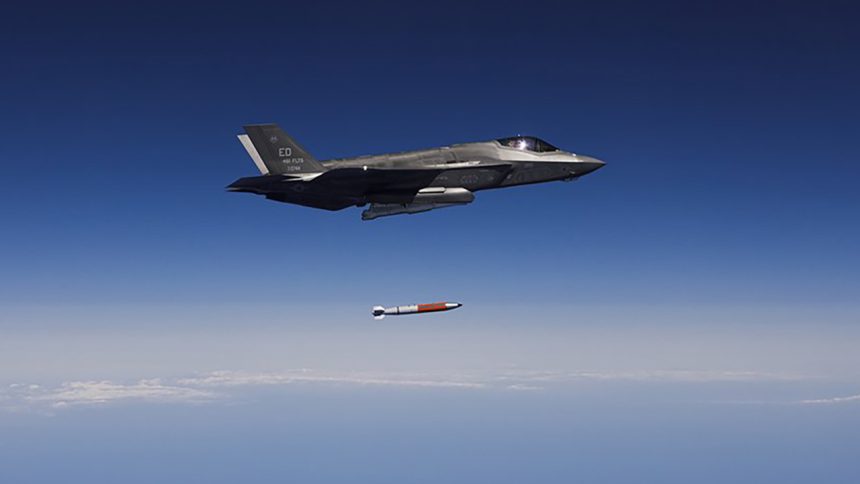The nuclear role transitions from the F-16 to the F-35.
Beginning on June 1, 2024, the F-35 will fully assume the Netherlands’ nuclear responsibilities within NATO, replacing the F-16, in what is yet another step towards the full transition from the “Viper” (as the F-16 is nicknamed among fighter pilots) to the Lightning II 5th generation aircraft.
The Netherlands, which contributes Dual-Capable Aircraft to NATO’s nuclear deterrence, will be the first European nation to switch to the F-35 for this role. Dutch Defence Minister Kajsa Ollongren updated the House of Representatives on this development today.
The shift from the F-16 to the F-35 for NATO’s nuclear mission has been planned for many years. Over recent years, the F-35 has undergone extensive testing and certification to take on the Netherlands’ nuclear responsibilities. Like the F-16s, the Dual-Capable Aircraft F-35 squadron dedicated to the nuclear mission will be based at Volkel Air Base.
On 1 June, the F-35A will take over the Dutch nuke sharing strike role from the F-16. This completes months of training and certification at Volkel Air Base. https://t.co/0CrcacC8L9
USAF stores 10-15 B61 bombs at base and plans to deploy new B61-12 soon. https://t.co/3MDEbSouuo pic.twitter.com/FyaYBqqDGr
— Hans Kristensen (@nukestrat) May 30, 2024
“This transition underscores the Netherlands’ ongoing dedication to NATO’s nuclear deterrence strategy, which is vital for the security of the Alliance and the Netherlands,” says the official Dutch MOD release. “The core purposes of NATO’s nuclear capability are to maintain peace, prevent coercion, and deter aggression.”
RNLAF F-35
The RNLAF (Royal Netherlands Air Force) plans to acquire a total of at least 46 F-35As, with 37 already ordered to replace the current fleet of F-16 MLU aircraft. The first operational F-35s arrived in the Netherlands from the Cameri Final Assembly and Check Out (FACO) facility in northwestern Italy in 2019.
The Netherlands became the eighth country, and the RNLAF the 12th military service, to declare Initial Operational Capability (IOC) for its F-35 fleet. This declaration was made by the Netherlands Ministry of Defence and the Royal Netherlands Air Force on December 27, 2021.
On Mar. 29, 2024, the air defense of the airspace of Belgium, the Netherlands and Luxembourg (BENELUX) was handed over from the F-16 to the new Dutch F-35A at Leeuwarden and Volkel Air Base.
F-35A DCA
The F-35A, the CTOL (Convetional Take Off and Landing) variant of the Lightning II aircraft, is a dual capable aircraft (DCA), meaning that it has the ability to deliver nuclear ordnance as well as conventional weapons. Such dual capability was included in the Block 4 software release, with initial capability for the B61-12 weapon.
Here’s some detail about the B61-12 from a past article published here at The Aviationist:
“The B61-12 represent the latest LEP (Life-Extention Program) upgrade to the B61 line of nuclear weapons that has already been extensively tested with the F-15E Strike Eagles of the 422nd Test and Evaluation Squadron, back in 2015.
The Life Extension Program or LEP, will replace the B61 -3, -4, -7, and -10 mods, with the -12 that, along with the B83, will become the only remaining gravity delivered nukes in the inventory.
“The B61-12 gravity bomb ensures the current capability for the air-delivered leg of the U.S. strategic nuclear triad well into the future for both bombers and dual-capable aircraft supporting NATO,” said Paul Waugh, AFNWC’s Air-Delivered Capabilities director in a U.S. Air Force release dated Apr. 13 (more or less when the world learned about the first use of the famous MOAB in Afghanistan). The B61-12 will be compatible with the B-2A, B-21, F-15E, F-16C/D, F-16 MLU, F-35 and PA-200 aircraft.
The LEP increases the B61’s accuracy so much that it will have the same capability against hardened targets as the much more powerful weapons it is replacing.”









